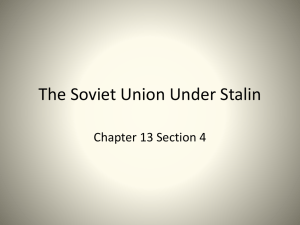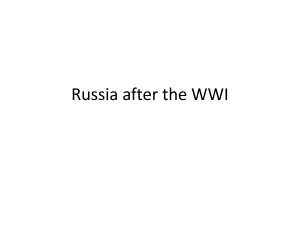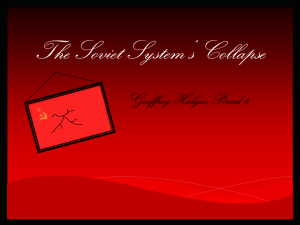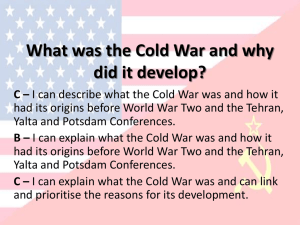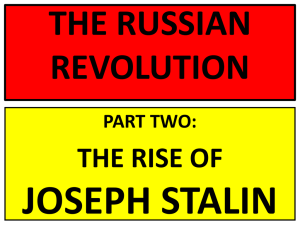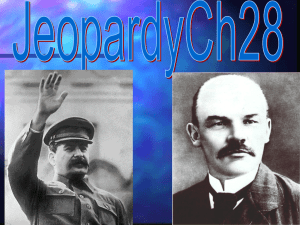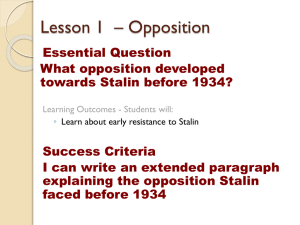The Stalin Revolution
advertisement
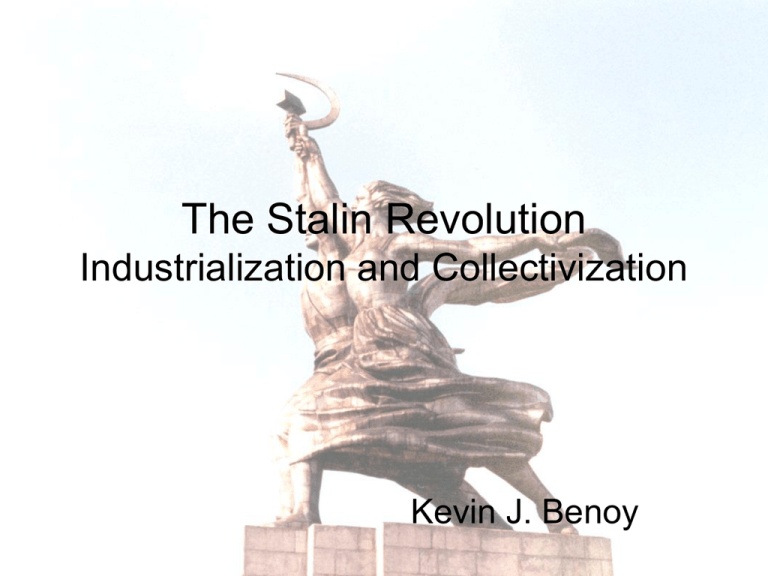
The Stalin Revolution Industrialization and Collectivization Kevin J. Benoy Background • By 1928 production in the USSR once again reached 1914 levels. • The NEP had served a useful purpose. • Why did Stalin decide to change course? Background • Was it ideological? – A vast increase in production was needed for the transition from Socialism to Communism. – Was Stalin trying to rush the process? Background • Was Stalin trying to turn the population into a vast proletariat that would form the social base necessary for this transition? Background • Was it a reaction to a perceived threat from without? • In 1931 Stalin said: “We must cover this distance in ten years. Either we do this or they will crush us.” • But in 1931, there was no substantial outside threat. Background • Perhaps the it had its roots in the political infighting that continued even after Stalin had come to dominate the party. • The strongest proponents of the NEP were, after all, Rykov and Bukharin – Stalin’s most recent adversaries. Two Goals • Whatever the case, 1928 was a pivotal year. Stalin announced two goals: – Collectivization of Agriculture – Stalin wanted to destroy the private farm and impose an industrial model on the countryside. – Massive Industrialization – Production would be stepped up enormously and, in doing so, he would destroy the power and influence of the Nepmen and their supporters within the Party. • The Vehicle for change in the countryside and the cities would be the First Five Year Plan. Centralized planning would determine everything. Collectivization • The Party had an inherent bias against the countryside. • Its ideology was based on proletarian interests. • Stalin now accused the farmers of not doing their bit. • Chief among his targest were the kulaks – the wealthier farmers. Collectivization • There really were not very many wealthy farmers. • Stalin was really just reversing Lenin’s policy of allying with the peasants. • Now the agrarian problem would be solved through the destruction of the peasantry in their current form. Collectivization • Any farmer could be accused of being a kulak – even entire villages were solabeled. • As “class enemies” they could be destroyed. Collectivization • Farmers were called upon to sign up for membership on two kinds of farms. – They might join a Sovkhoz – a state farm, where they would serve as labourers on a state owned farm. – They might join a Kolkhoz, a collective farm, which involved some sort of joint ownership on the part of the membership. Collectivization. • On January 20, 1930 there were a little over 4 million collective farm peasants. • By March 1, 1930 there were over 14 million. • The result was not improved agriculture, but disaster. Collectivization. • Most went only unwillingly. • Once signed up, there was often no organization ready for them. • Stalin made his “Dizzy from success” speech, where he called for a slowing down to let organization catch up. Collectivization • By May 1, 1930, the number dropped to 6 million. • Yet the goal remained unchanged. This was delay, not retreat. • B y the end of 1932, 60% of peasant families were collectivized. At a huge cost to the peasantry. Collectivization • Collectivization sometimes resembled civil war. • One OGPU (security police) colonel told a foreign journalist: – “I am an old Bolshevik. I worked in the underground against the Tsar and then I fought in the Civil War. Did I do all that in order that I should now surround villages with machine guns and order my men to fire indiscriminately into crowds of peasants? Oh, no, no.” Collectivization • Agricultural production dropped substantially. – In 1933 the number of horses in the USSR was less than half of the 1928 figure. – In 1937, per capita production of all farm products was below the pre1928 level. – Cattle numbers fell by 1/3, sheep and goats by half. – Horses could be replaced by tractors; nothing could replace other animals. Famine • As many as 5 million peasants died in the campaign and the 1932 famine – a disaster every bit as bad as that of 1921, but this time there could be no outside help as Stalin would not even admit there was a problem. Collectivization • Historian JP Nettle, The Soviet Achievement, notes: – “…the squeeze and the Five Year Plan based on it were not relaxed. Agricultural production fell substantially in the early period of collectivization, but the quota of compulsory food deliveries to the state was maintained almost intact – the first commandment – as Stalin called it. The difference was made up in the kitchens and hearths of the collective households.” • The Farmers of the Soviet Union would be made to pay the vast cost of industrializing the country. The money could not be raised voluntarily within the USSR, nor could it be borrowed abroad. It was plied from the pockets of the peasants. Industrialization • The first five year plan was adopted in April, 1929. • Priority was given to heavy industrial, not consumer goods. – Total output was to increase 250%. – Heavy Industrial output was to grow 330%. – Pig iron output was to increase 300%. – Coal production – 200%. – Electrical productionn – 400%. Industrialization • When some party leaders challenged the figures, Stalin had them raised – eventually calling for the completion of the plan in four, not five years. Industrialization • Targets were impossible. • Supply and distribution problems arose. – Buildings were put up and no equipment provided. – Equipment rusted because it was delivered to a place with no building to house it. Industrialization • Shoddy products were produced that could not function – just to reach production targets. • Sometimes transportation facilities didn’t move products to their final destinations. Industrialization • Despite the problems, Stalin remained unmoved. • Economic goals must have been secondary to Stalin. – What he wanted was a transformation of Soviet society. – All were to be made subservient to the state. – It worked. Labour Changes • After 1928, with the increase in labour demand, a system of “organized intake” was arrived at. • Collective farm chairmen could send workers into factories when agreements were reached with industrial managers. Labour Changes • Piece rate wages replaced fixed salaries. • The Marxist slogan “from each according to his ability, to each according to his need” was replaced with “from each according to his ability, to each according to his work.” Labour Changes • In 1929 Stalin fired Tomsky and replaced him with a loyal crony – Kaganovich. • The duty of unions now came to be to ensure higher production. Labour Changes • In 1931 and 1932, legislation was passed forcing workers to go wherever the authorities sent them. Labour Changes • In 1932, workers guilty of one day’s voluntary absence from a job were dismissed and deprived of their housing. Labour Changes • In 1932, the old Tsarist system of internal passports was revived. Now people could only move with police consent. Industrialization • The Great Proletarian Revolution had been offered as a cure for the horrible conditions of the early industrial revolution. • Now it served as an excuse for the introduction of just such ills. The New Soviet Man • While politics and economics had been somewhat separated during the NEP period, now they were inextricably linked. • To fail to produce one’s quota was not just an industrial failing, but a political failing too. The New Soviet Man • Newspapers were full of stories of industrial heroes – models for all Soviet citizens to copy. • Stakhanov – a coal worker over-fulfilled his quota by 1400% (Of course it was a set-up). Now all workers were to copy him. The New Soviet Man • Even Science was not immune. • Trofim Lysenko, a plant breeder, falsely claimed that an acquired trait could be passed along genetically. • Stalin promoted him to head of the Academy of Agricultural Sciences of the USSR. The New Soviet Man • People in all areas had their work allotted them. • Even writers, filmmakers and artists had to conform to “Soviet Realism” – a new conformity. • The days of experimentation were over. The First Five Year Plan • When it ended, after 4 years, the 1st 5 year Plan was a failure in terms of reaching its targets – in agriculture and industry. • It did produce a new society. • The Soviet pattern of big enterprises was established. • All workers were subservient to the state. • Money for foreign purchases was expropriated from nepmen and farmers. • Central Asia and Siberia were opened for development. The Stalin Revolution • Overshadowing the Second Five Year Plan was a far more important event – or series of events – which makes its achievements and failures dim in comparison – The Great Purge. The Second Five Year Plan • Announced in 1933, it was to be completed in 1937. • It aimed to “eliminate completely the capitalist elements” in the USSR. – Though by this time, private businesses and trade had disappeared – except for the products of market plots – and, of course, the black market. The Second Five Year Plan • In this plan, the focus was on producing better quality goods, since those of the first plan were terrible. • Wage differences grew. • In agriculture, at last, tractors arrived at the new Motor Tractor Stations. finis

